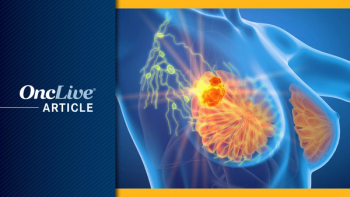
- November 2013
- Volume 14
- Issue 11
Targeting PI3K: A New Generation of Agents Emerges
The phosphatidylinositol 3-kinase pathway is frequently deregulated in cancer at multiple different points, and has therefore emerged as one of the most deeply explored cell-signaling networks in oncogenic research.
Basic Elements of PI3K Pathway
This figure depicts key players in the PI3K/Akt/mTOR cellsignaling network, including kinases, multiproteins, and the phosphatase PTEN.
The phosphatidylinositol 3-kinase (PI3K) pathway is frequently deregulated in cancer at multiple different points, and has therefore emerged as one of the most deeply explored cell-signaling networks in oncogenic research. Yet currently, the only FDA-approved PI3K pathway inhibitors target a single node of this pathway, the mammalian target of rapamycin (mTOR). The substantial complexity of the PI3K pathway, driven by feedback loops and crosstalk with other signaling pathways, drives a significant amount of resistance to these therapies.
A broader array of PI3K pathway-targeting agents are now beginning to undergo clinical testing, including inhibitors of the central enzyme PI3K, and there is much interest in the potential antitumor efficacy of these next-generation agents in a variety of different cancers, as well as their role in overcoming resistance to other therapies driven by the activation of the PI3K pathway.
Oncogenic Potential of the PI3K Pathway
The PI3Ks are a large family of kinases that function as intracellular messengers to orchestrate an array of important cellular processes, such as growth, survival, and metabolism. The PI3K family is divided into three classes, each of which has a distinct structure, distribution in the cell, and mechanism of action. The class I PI3Ks are the most widely implicated in the development of cancer.
Typically activated by receptor tyrosine kinases (RTKs) or G proteincoupled receptors (GPCRs), the class I PI3Ks are responsible for the conversion of the membrane lipid phosphatidylinositol- 4,5-bisphosphate (more commonly known as PIP2) into phosphatidylinositol-3,4,5- trisphosphate (PIP3), via addition of a phosphate group to the 3’ position of its inositol ring. PIP3 then binds to and activates a host of target intracellular proteins; perhaps most significant among them is the serine/threonine kinase Akt (also known as protein kinase B).
Akt, in turn, activates a range of downstream signaling targets, including another serine/threonine kinase, mTOR. A master regulator of protein synthesis and other important biological processes, mTOR functions as part of two different multiprotein complexes, mTORC1 and mTORC2. It is such an oncogenically relevant downstream target of this pathway that the network is often referred to as the PI3K/Akt/mTOR pathway. The conversion of PIP2 to PIP3 by PI3K is counterbalanced by the phosphatase PTEN (phosphatase and tensin homolog), which catalyzes the reverse reaction.
The class I PI3Ks are composed of a regulatory and a catalytic subunit (known as p85 and p110, respectively). There are several isoforms of each; for example, the catalytic subunits are p110α, β, δ, and g, encoded by the PIK3CA, PIK3CB, PIK3CD, and PIK3CG genes, respectively. p110α and β are ubiquitously expressed throughout the cell, while PI3Kg and δ are preferentially expressed in white blood cells.
The PI3K pathway is among the most heavily investigated in cancer from a therapeutic standpoint, a fact that is reflected by the wide number of agents now in clinical trials. The main reason for this interest is that almost every node of the pathway has been found to be altered in cancer. The most commonly observed alterations include mutation or amplification of the PIK3CA gene, loss of PTEN expression, or hyperactivation of RTKs.
First-Generation PI3K Pathway- Targeting Agents
The prototypical agents targeting the PI3K pathway were a naturally occurring PI3K inhibitor, wortmannin, and a morpholine derivative of quercetin, LY294002. These compounds were instrumental in defining the biological role of PI3K, but they demonstrated poor pharmacokinetics and thus had limited therapeutic potential.
The first agents to enter the clinic were those targeting the downstream effector mTOR. Rapamycin (sirolimus) is a naturally occurring compound isolated from the soil bacterium Streptomyces hydroscopius, a potent inhibitor of mTORC1. Limitations in the solubility and pharmacokinetic properties of rapamycin led to development of rapamycin analogues with improved characteristics, including temsirolimus and everolimus.
Randomized phase III trials confirmed efficacy of these agents and led to their FDA approval for a range of oncology indications. For example, temsirolimus was approved in 2007 for the treatment of renal cell carcinoma based on a trial showing that it was superior to interferon treatment and prolonged median progression-free survival (PFS) by 2.4 months. While they have shown significant efficacy as monotherapy, they have demonstrated the most impressive activity in combination with endocrine therapy for the treatment of breast cancer. Everolimus in combination with exemestane in cancer patients previously treated with nonsteroidal hormone therapy improved median PFS by 4.6 months, compared with exemestane alone, according to updated investigator assessments in the BOLERO-2 trial.
However, there is a significant amount of complexity in the PI3K pathway, including crosstalk with other pathways and regulatory feedback loops, which activate PI3K signaling upon mTOR inhibition. This can seriously undermine the efficacy of mTOR inhibitors, and nearly all patients treated with these agents eventually relapse.
Next Generation: Targeting Multiple Pathway Nodes
An array of newer and more potent compounds has begun to enter clinical testing in recent years, with several reaching late-stage trials.
Pan-PI3K Inhibitors
With the aim of improving the pharmacologic potential of wortmannin and LY294002, pan-PI3K inhibitors were among the earliest agents to enter clinical trials. They are adenosine triphosphatase (ATP)-competitive inhibitors that target all of the p110 isoforms (Table 1).
The most advanced is Novartis’ BKM120, which has shown significant clinical activity, particularly in hormone receptor-positive breast cancer. Studies have demonstrated that PI3K inhibition can cause compensatory activation of the estrogen receptor in breast cancer patients; thus, the combination of hormone therapies and PI3K inhibitors is an area of significant research.
Table 1. PI3K Inhibitors in Clinical Development
Agent
Companya
Target
Development Stage/Tumor Type(s)
(NCT identifier)b
SAR245408 (XL147)
Sanofi
Pan-PI3K
Phase I solid tumors, lymphoma
(NCT01392924, NCT01943838)
PX-866
Oncothyreon
Irreversible pan-PI3K
Phase I/II glioblastoma, advanced melanoma, solid tumors
(NCT01616199, NCT01259869, NCT01204099)
BKM120
Novartis
Pan-PI3K
Phase III breast cancer; phase I/II NSCLC, melanoma, head and neck cancer, and others
(NCT01633060, NCT01297491, NCT01512251, NCT01816984)
GDC-0941
Genentech
Pan-PI3K
Phase I/II breast cancer, NSCLC, solid tumors
(NCT01918306, NCT01493843, NCT00996892)
BYL719
Novartis
PI3Kα
Phase I/II head and neck cancer, breast cancer, solid tumors
(NCT01602315, NCT01870505, NCT01928459)
GSK2636771
GlaxoSmithKline
PI3Kβ
Phase I advanced solid tumors
(NCT01458067)
BAY 80-6946
Bayer
Pan-PI3K
Phase I/II NHL, advanced cancer
(NCT01660451, NCT01460537)
GDC-0032
Genentech
PI3Kα
Phase I breast cancer
(NCT01296555, NCT01862081)
MLN1117 (INK1117)
Millennium Pharmaceuticals
PI3Kα
Phase I advanced cancer
(NCT01449370)
GS-1101 (idelalisib)
Gilead Sciences
PI3Kδ
Phase III NHL, CLL; phase I/II low-grade lymphoma
(NCT01732913, NCT01659021, NCT01306643)
ZSTK474
Zenyaku Kogyo Co, Ltd
Pan-PI3K
Phase I solid tumors
(NCT01280487)
SAR260301
Sanofi
PI3Kβ
Phase IB advanced cancer
(NCT01673737)
IPI-145
Infinity Pharmaceuticals
PI3Kδ/g
Phase II indolent NHL
(NCT01882803
CH5132799
Chugai Pharma
Europe, Ltd
Pan-PI3K
Phase I advanced solid tumors
(NCT01222546)
AMG319
Amgen
PI3Kδ
Phase I lymphoid malignancies
(NCT01300026)
aClinical development programs may include other sponsors and/or collaborators.
bClinical trial records available at the NIH Clinical Trials Registry, www.ClinicalTrials.gov.
CLL indicates chronic lymphocytic leukemia; NHL, non-Hodgkin lymphoma; NSCLC, non-small cell lung cancer.
BKM120 is being evaluated in two phase III trials in combination with the estrogen receptor antagonist fulvestrant. The BELLE-2 (which excludes prior mTOR therapy) and BELLE-3 (which requires prior mTOR therapy) trials are evaluating this combination in postmenopausal women with locally advanced HER2-negative breast cancer whose disease progressed on or after aromatase inhibitor therapy.
Isoform-Specific PI3K Inhibitors
The modest efficacy observed in early trials of nonspecific PI3K inhibitors drove the development of more specific PI3K inhibitors that target individual p110 isoforms, with the theoretical advantage that they may be less toxic and could be used at higher, more active doses.
Currently, there is a significant amount of interest in the use of PI3Kα inhibitors in cancers with PIK3CA mutations; PI3Kα inhibitors, such as GDC0032 (Genentech), have shown remarkable clinical activity in PIK3CA-mutant breast cancer. There is also interest in the use of PI3Kβ inhibitors in tumors with PTEN loss; the transforming effects of PTEN loss have been shown to be dependent on PI3Kβ in prostate cancer. Finally, in hematologic malignancies, PI3Kδ is preferentially expressed on white blood cells, and many B-cell cancers, including chronic lymphocytic leukemia (CLL) and indolent non-Hodgkin lymphoma (NHL), have been shown to use PI3Kδ signaling to drive proliferation and survival.
Table 2a. Pan-Akt Inhibitors in Development
Agent
Companya
Development Stage/Tumor Type(s)
(NCT identifier)b
MK-2206
Merck
Phase I/II prostate cancer, kidney cancer, solid tumors, breast cancer, CRC
(NCT01480154, NCT01277757, NCT01802320)
AZD5363
AstraZeneca
Phase I/II breast cancer, prostate cancer
(NCT01625286, NCT01692262)
Triciribine (TCN-PM)
Cahaba Pharmaceuticals
Phase I/II breast cancer
(NCT01697293)
AR-67 (DB-67)
Arno Therapeutics
Phase II myelodysplastic syndrome
(NCT00930540)
AR-42
Arno Therapeutics
Phase I multiple myeloma, CLL, lymphoma, AML
(NCT0112913, NCT01798901)
GDC-0068
Genentech
Phase II gastric cancer or GEJ cancer; phase I solid tumors
(NCT01896531, NCT01090960)
ARQ 092
ArQule, Inc
Phase I advanced solid tumors, malignant lymphoma
(NCT01473095)
aClinical development programs may include other sponsors and/or collaborators.
bClinical trial records available at the NIH Clinical Trials Registry, www.ClinicalTrials.gov.
AML indicates acute myeloid leukemia; CLL, chronic lymphocytic leukemia; CRC, colorectal cancer; CRPC, castration-resistant prostate cancer;GEJ, gastroesophageal junction; NHL, non-Hodgkin lymphoma; PNET, progressive neuroendocrine tumor; RCC, renal cell carcinoma.
PI3Kδ inhibitors have demonstrated efficacy in CLL, with Gilead’s idelalisib (GS-1101) as the most advanced in this category. It has been shown to inhibit proliferation and induce apoptosis in many B-cell malignancies and to reduce B-cell survival. In a phase II trial in combination with rituximab in rituximab-naïve patients aged 65 years and over, it demonstrated an overall response rate (ORR) of 96%, while in indolent NHL, when evaluated as both monotherapy and in combination with rituximab and bendamustine, it produced ORRs of 48% and 81%, respectively. Idelalisib has been shown to partially reverse stroma-induced resistance to conventional chemotherapy in CLL. It is currently in phase III trials in combination with rituximab in NHL and in combination with ofatumumab in CLL. Gilead reported recently that the phase III trial in CLL was being stopped early because it demonstrated highly statistically significant efficacy for the primary endpoint of PFS.
Akt Inhibitors
Inhibitors of the next kinase in the pathway, Akt, are also beginning to progress through clinical development (Table 2a). There are three isoforms of Akt (Akt1, 2, and 3) and thus far only pan-Akt inhibitors have been developed. Due to the structural similarities between the three isoforms, producing isoform-specific inhibitors has proved challenging. Akt inhibitors are either allosteric (eg, MK-2206) or ATP-competitive (eg, GDC-0068).
mTOR Inhibitors
In order to improve upon the efficacy of the firstgeneration “rapalogs,” a number of mTOR inhibitors have now been developed that target both the mTORC1 and mTORC2 complexes for a more complete suppression of mTOR function (Table 2b). In preclinical trials, these agents have been shown to be superior to inhibitors that target mTORC1 alone, and to possess greater ability to inhibit activation of downstream targets of mTOR. Furthest along in development is ridaforolimus, which is currently undergoing phase III clinical trials in sarcoma.
Dual PI3K/mTOR Inhibitors
Researchers have exploited the similarity between the ATP-binding sites of PI3K and mTOR to generate dual inhibitors that target not only all isoforms of PI3K, but also both mTOR complexes (Table 2c). These may offer the best chance to shut down the pathway at multiple points, while also blocking off the feedback loop that activates Akt when mTOR is inhibited. Thus far, they have demonstrated only modest clinical activity in early-stage clinical trials, but researchers are working to optimize dosing and scheduling, and also to examine the potential of these dual inhibitors in combination with other agents. In fact, given the complexity of the PI3K/Akt/mTOR signaling network, combination therapy is likely to hold the key to maximizing the efficacy of all of these agents.
Overall, the toxicities observed with all of the PI3K pathway-targeting agents under evaluation have been very similar, and these agents are reasonably well tolerated. There were no unexpected adverse effects or dose-limiting toxicities, with the most common being hyperglycemia, skin toxicity, stomatitis, and gastrointestinal intolerance (eg, diarrhea, vomiting). All adverse events were mild to moderate and were manageable with supportive medication. While some toxicities were likely due to off-target effects, many were directly related to the mechanism of action of these drugs.
Table 2b. mTOR Inhibitors in Development
Agent
Companya
Target
Development Stage/Tumor Type(s)
(NCT identifier)b
Everolimus (Afinitor)
Novartis
mTORC1
FDA approved in 2009; now indicated in certain advanced or metastatic breast cancer, pancreatic origin PNET, and RCC populations
Temsirolimus (Torisel)
Pfizer
mTORC1
FDA approved in 2007; indicated in advanced RCC
Ridaforolimus (MK-8669)
Merck
mTORC1
Phase III sarcoma completed in 2013; phase II endometrial cancer, breast cancer
(NCT00538239, NCT00770185, NCT01234857)
AZD-8055
AstraZeneca
mTORC1/2
Phase I recurrent glioma
(NCT01316809)
OSI-027
Astellas Pharma
mTORC1/2
Phase I advanced solid tumors/lymphoma completed
(NCT00698243)
MLN0128 (INK128)
Millennium Pharmaceuticals
mTORC1/2
Phase I advanced solid and hematologic malignancies
(NCT01058707, NCT01351350)
AZD2014
AstraZeneca
mTORC1/2
Phase I breast cancer
(NCT01597388)
CC-223
Celgene Corporation
mTORC1/2
Phase I/II advanced solid tumors, NHL, multiple myeloma
(NCT01177397)
aClinical development programs may include other sponsors and/or collaborators.
bClinical trial records available at the NIH Clinical Trials Registry, www.ClinicalTrials.gov.
AML indicates acute myeloid leukemia; CLL, chronic lymphocytic leukemia; CRC, colorectal cancer; CRPC, castration-resistant prostate cancer;GEJ, gastroesophageal junction; NHL, non-Hodgkin lymphoma; PNET, progressive neuroendocrine tumor; RCC, renal cell carcinoma.
Predicting Response Remains Challenge
One of the most significant challenges to the effective clinical development of PI3K pathway-targeting agents is to identify patient populations that are most likely to benefit from this kind of therapy. Using PIK3CA mutations as positive predictors of response to PI3K-targeted agents would seem like the obvious route, but is proving problematic. Researchers have discovered that there is no clear correlation between molecular alterations in the PI3K pathway and antitumor efficacy of PI3K-targeting agents. While some responders have aberrations in the PI3K pathway, others do not, and some do not respond despite harboring pathway mutations.
The confusion is thought to be due in part to the heterogeneity of these tumors, since studies suggest that PIK3CA mutational status differs between primary and metastatic lesions. In clinical trials, archival tissue is frequently used to assess mutation status; however, this may not accurately reflect the status of the tumor at the time that therapy is being administered. There also may be a context dependence to molecular alterations in the PI3K pathway, and it will be important to determine a way to differentiate between tumors that are addicted to the PI3K pathway, those that are dependent upon it, and those that are resistant.
Table 2c. Dual PI3K/mTOR Inhibitors in Development
Agent
Companya
Development Stage/Tumor Type(s)
(NCT identifier)b
PF-05212384 (PKI-587)
Pfizer
Phase II endometrial cancer, metastatic CRC
(NCT01420081, NCT01925274)
GDC-0980
Genentech
Phase II breast cancer, CRPC, endometrial carcinoma, RCC; phase I in various tumor types
(NCT01437566, NCT01485861, NCT01455493, NCT01442090)
NVP-BEZ235
Novartis
Phase I/II CRPC, RCC, breast cancer
(NCT01717898, NCT01453595, NCT01495247)
GSK2126458
GlaxoSmithKline
Phase I advanced solid tumors, lymphoma
(NCT00972686)
aClinical development programs may include other sponsors and/or collaborators.
bClinical trial records available at the NIH Clinical Trials Registry, www.ClinicalTrials.gov.
AML indicates acute myeloid leukemia; CLL, chronic lymphocytic leukemia; CRC, colorectal cancer; CRPC, castration-resistant prostate cancer;GEJ, gastroesophageal junction; NHL, non-Hodgkin lymphoma; PNET, progressive neuroendocrine tumor; RCC, renal cell carcinoma.
Jane de Lartigue, PhD, is a freelance medical writer and editor based in Davis, California.
Key Research
Baselga J. Targeting the PI3K pathway in the therapy of breast cancer: current status and future directions. Presented at 30th Annual Miami Breast Cancer Conference; March 7-10, 2013; Miami Beach, FL.
Bitting RL, Armstrong AJ. Targeting the PI3K/Akt/mTOR pathway in castration-resistant prostate cancer. Endocr Relat Cancer. 2013;20(3):R83-R99. doi:10.1530/ERC-12-0394.
Brana I, Siu LL. Clinical development of phosphatidylinositol 3-kinase inhibitors for cancer treatment. BMC Medicine. 2012;10:161-176.
Cidado J, Park BH. Targeting the PI3K/Akt/mTOR pathway for breast cancer therapy [published online ahead of print August 4, 2012]. J Mammary Gland Biol Neoplasia. 2012;17(3-4):205-216.
Czuczman MS. PI3-kinase delta in hematologic malignancies. Presented at 11th Annual International Congress on Targeted Therapies in Cancer; August 16-17, 2013; Washington, DC.
Fu X, Osborne CK, and Schiff R. Biology and therapeutic potential of PI3K signaling in ER+/HER2-negative breast cancer [published online ahead of print September 5, 2013]. Breast 2013;22(suppl 2): S12-S18.
Martini M, Ciraolo E, Gulluni F, Hirsch E. Targeting PI3K in cancer: any good news? Front Oncol. 2013;3(108):1-9.
Owonikoko TF, Khuri FR. Targeting the PI3K/AKT/mTOR pathway: biomarkers of success and tribulation. 2013 ASCO Educational Book. American Society of Clinical Oncology website. http://meetinglibrary.asco.org/content/131-132.
Rodon J, Dienstmann R, Serra V, Taberno J. Development of PI3K inhibitors: lessons learned from early clinical trials [published online ahead of print February 12, 2013]. Nat Rev Clin Oncol. 2013;10(3):143-153.
Articles in this issue
about 12 years ago
FALCON Trial Compares Two Types of Endocrine Therapyabout 12 years ago
Hematologic Immunotherapy Breaks New Ground in Established Fieldabout 12 years ago
Mammogram Study Provides Rationale for Expanding Screening Programsabout 12 years ago
RCC Care Evolving With Targeted and Novel Agentsabout 12 years ago
Lymphoma Research Focuses on Targeting Genetic Driversabout 12 years ago
Swallowing Exercises Help to Preserve Function After RT and CRT
























































































